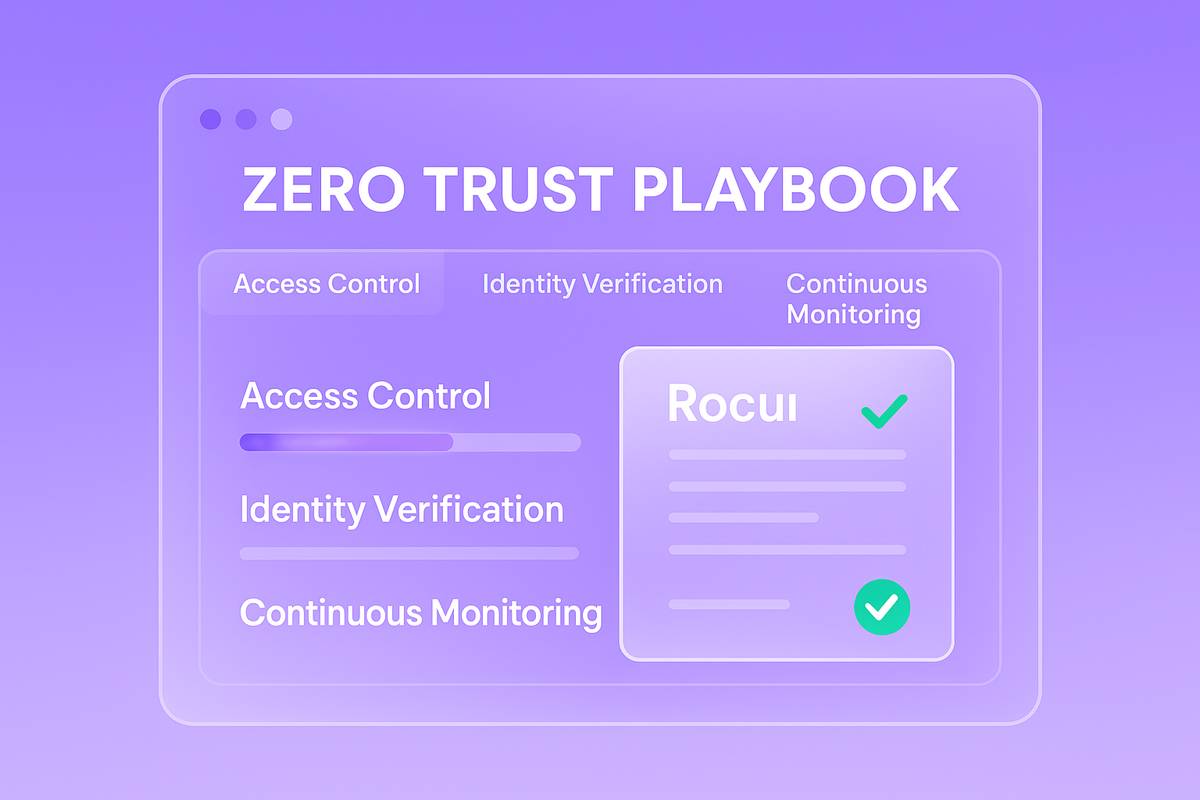The Practical Zero Trust Playbook for 2025
December 12, 2023
By
Evie Secilmis

Why Zero Trust Security Matters for Modern Businesses
In today’s digital-first world, where cyber threats evolve daily, Zero Trust security is no longer just a buzzword — it’s a critical framework for businesses that want to protect their data and stay resilient. The Zero Trust model, famously defined as “never trust, always verify,” has become the new playbook for cybersecurity and data protection.
What Is Zero Trust?
At its core, Zero Trust eliminates implicit trust in networks, applications, and users. Instead of assuming anything inside your system is safe, every digital step — from a login to an API call — must be verified, authenticated, and continuously monitored.
For forward-thinking companies like Iris, Zero Trust isn’t about chasing a trend. It’s about being proactive and adaptive in a world where traditional firewalls and perimeter defenses are no longer enough. Cyber walls are constantly shifting, and the best way to stay ahead is to adopt a Zero Trust mindset that prioritizes security at every layer.
Understanding CISA’s Zero Trust Maturity Model
The Cybersecurity and Infrastructure Security Agency (CISA) introduced the Zero Trust Maturity Model — a framework that helps organizations assess and implement Zero Trust architecture effectively. This model is a roadmap for how enterprises can move from reactive security to proactive, continuous verification.
CISA’s model helps organizations:
- Assess their current cybersecurity posture
- Create a roadmap for implementing Zero Trust
- Reduce risks through continuous verification, validation, and monitoring
If you’re interested in learning how Zero Trust fits within broader information security programs, Iris’s platform offers integrated tools for compliance, audits, and real-time risk management.
Why Zero Trust Is Essential for Businesses Like Iris
For AI-driven companies like Iris, Zero Trust goes beyond compliance — it’s foundational to how data is managed and protected. It enables organizations to:
- Safeguard sensitive data across finance, healthcare, and education sectors
- Verify and authenticate every request, user, and system interaction
- Build customer trust through transparent security and compliance practices
- Prepare for future regulatory frameworks that demand continuous validation
By embedding Zero Trust into both technology and company culture, Iris is redefining AI-powered cybersecurity for the modern enterprise.
Zero Trust as a Mindset Shift
Implementing Zero Trust isn’t just a technical initiative — it’s a cultural transformation. Every employee, system, and workflow must operate under the principle of least privilege and continuous verification. This shift ensures security isn’t an add-on — it’s built into the DNA of your organization.
Teams using Iris Pro and Phoenix can embed these principles directly into their workflows, ensuring security scales alongside collaboration and productivity.
How AI and Zero Trust Work Together
AI enhances Zero Trust architecture by making it intelligent, adaptive, and automated. Traditional Zero Trust relies on manual verification, but AI can identify risk patterns in real time and respond faster than human teams ever could.
Using Iris’s AI-driven features — like AI Drafting, Knowledge Map, and Integrations — organizations can continuously monitor access, behavior, and permissions across systems. If an unusual login occurs, a new API endpoint is hit, or a data transfer spikes unexpectedly, Iris can automatically trigger alerts, restrict access, or request additional authentication.
This blend of AI and Zero Trust ensures that every digital interaction is verified intelligently, not just mechanically — giving businesses both speed and security.
Building a Zero Trust Roadmap
Adopting Zero Trust isn’t a one-time project; it’s a continuous journey of validation, monitoring, and improvement.
1. Assess your current environment
Map your users, data flows, and access points. Identify areas of implicit trust — like shared credentials or open integrations.
2. Define your architecture
Set clear rules for identity, devices, applications, and networks. Every connection should go through validation using modern tools like MFA and adaptive risk scoring.
3. Implement least-privilege access
Grant only the permissions required for each role. Layer this with continuous monitoring via security questionnaires and automated alerts.
4. Monitor continuously
Use AI-powered monitoring and integrated security analytics to detect anomalies, validate behavior, and refine policies dynamically.
By combining Iris Pro with its automation and compliance workflows, organizations can move toward a state of Zero Trust confidence — not just compliance.
Final Thoughts
Zero Trust security is now the gold standard for enterprise resilience. With CISA’s Zero Trust Maturity Model leading the way, it’s clear that organizations must embrace continuous verification as a baseline, not a luxury.
For businesses like Iris, Zero Trust means smarter, faster, and more adaptive defense — ensuring that every interaction is secure, verified, and resilient.
👉 Learn how Iris helps teams adopt Zero Trust with AI. Explore our Responsible AI policies to see how automation, analytics, and AI work together to safeguard every step of your digital workflow.
Frequently Asked Questions
1. Is Zero Trust the same as traditional network security?
No. Traditional security trusts everything once inside the network. Zero Trust verifies every user, device, and action — everywhere.
2. How does AI strengthen a Zero Trust framework?
AI continuously analyzes context and behavior to detect risks before they escalate. With Iris Pro, every digital action is intelligently verified in real time.
3. Is adopting Zero Trust difficult for existing systems?
Not necessarily. Start small with identity and access management, then scale across devices, data, and networks. Iris helps you prioritize, automate, and scale efficiently.
4. Does Zero Trust slow down productivity?
When implemented with AI and automation, Zero Trust enhances efficiency by authenticating in the background without adding friction.
5. How can Iris help achieve Zero Trust compliance?
Iris embeds Zero Trust verification, AI-powered automation, and continuous monitoring into every layer — ensuring compliance across frameworks like SOC 2, ISO 27001, and GDPR.
Share this post
Link copied!




















